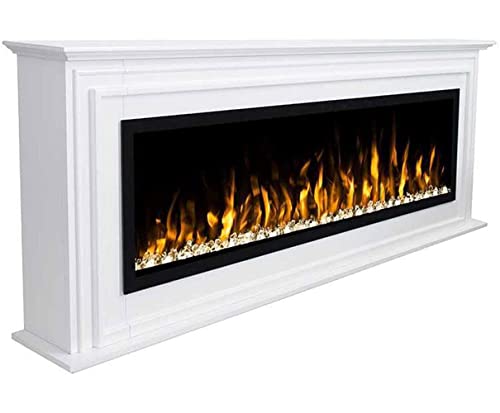What's The Current Job Market For Wood Burner Fireplace Professionals?
페이지 정보
작성자 Earle Boudreaux 작성일24-11-12 21:18 조회14회 댓글0건관련링크
본문
 How to Get the Most From a Wood Burner ethanol fireplace
How to Get the Most From a Wood Burner ethanol fireplaceUnlike traditional open cheap fireplaces wood stoves are designed and optimised to burn firewood. This allows them to meet stricter emission standards.
Wood burning stoves are renowned for their dancing yellow flames, cosy crackling sounds and that primal feeling of warmth. The smoke that is generated is filled with harmful air pollutants such as formaldehyde, benzene, and polycyclic aromatic hydrocarbons.
Efficient
Fireplaces and stoves that are wood-burning are not only stunning, but they are also incredibly efficient. A good quality wood burner can be able to achieve an Ecodesign rating of as high as 77 percent. With the rising cost of energy, it is essential to make sure you are getting the maximum benefit from your log burner - the good news is that this is much easier than ever!
One of the main factors that determines the efficiency of a wood-burning stove can be will be the water content of the wood. We recommend using only seasoned wood that has been dried over a period of at least one year and often two years. The more dry the wood more dry, the better it burns. This results in lesser smoke and fewer harmful emissions.
A wood-burning stove also is a low-carbon fuel source, which is good for the environment. By purchasing locally sourced wood, you can also help to support the active management and conservation of woodlands. This is great for wildlife.
The only thing a wood burning stove requires in terms of maintenance is to regularly remove and get rid of ash. This can be a bit of a nuisance, but it is worth it to ensure you get the maximum heat from each and every log. If you allow the ashes 2-3 days to cool completely, they can also be used as a non-toxic, green melting ice. They can be used to polish jewelry or absorb the odors.
A fireplace with a wood burner is a timeless classic. Although they're less popular than gas fireplaces, there is no denying the appeal and enthralling sound of a roaring ethanol fire. These fires are perfect to snuggle in on cold winter nights, and make a warm and inviting space in your home. Make sure you invest in a high-quality wood burner and you'll be reaping the benefits for many years to be! Our chimney sweeps are on hand to help you get the most value from your stove - give us a call today to find out more.
Low Carbon
Wood burners that burn efficiently and cleanly are the most efficient way to save money while also keeping your home warm. They also aid local woodland management. This is a fantastic way to support the wildlife that lives in your neighborhood.
Wood-burning stoves and fireplaces produce very little pollution if they are properly maintained and used with dry, seasoned and dry firewood. When they are not properly maintained or when they make use of wood that is not of high quality, the smoke that is produced is a result of fine particles, commonly referred to as particulate pollution that can cause irritation to lung organs and other body organs. It also contains carbon monoxide as well as harmful air pollutants such as formaldehyde, benzene, and polycyclic aromatic hydrocarbons. Inhaling this kind of air pollution can cause irritation to the lung, coughing, wheezing and asthma attacks. It could even cause serious health issues such as heart disease, cancer, or premature death.
Some people are worried that wood-burning stoves contribute to climate change However, this isn't true. Wood burning produces energy that is carbon neutral. The wood absorbs carbon dioxide throughout its lifespan. After burning carbon dioxide is released into the air.
Since the wood is sourced locally this decreases the amount of pollution emitted in the process of transportation. It is important to use hardwoods that have been seasoned and of high quality. They will burn longer and more evenly than softwoods.
Modern wood stoves, including those manufactured by Charlton & Jenrick, emit much less pollution than older stoves. They have been tested and certified to meet 2020 EPA standards, which are significantly more stringent than the previous emission limits.
All wood burning stoves must be fully vented to the outside of your property to ensure that they do not create a haze of exhaust within your home. By keeping the flames in the vicinity of the logs, and ensuring you use dry, seasoned wood, all our current clean burn and DEFRA exempt stoves produce very clear exhaust and have particulate levels 60 or more lower than the DEFRA limit.
A wood-burning stove with a catalytic converter is the best low carbon heating solution. These units re-ignite the particulates and gases from the initial combustion in a second stage by mixing them with superheated air. They then funnel the remaining gasses and particulates through a catalytic combustion combustor for the third and final combustion, further reducing emissions to a level that is well below the government standards.
Clean Burn
Cleanburn wood stoves burn fuel with the highest possible efficiency. This results in a minimum amount of emissions of particles into the air when burning wood. The stove's air management system regulates the intake and exhausting of gases, ensuring the combustion process is conducted in a closed, controlled environment. It also regulates the flame's height to maximise the output of heat and reduce emissions.
This means that your chimney and the surrounding area will be much cleaner than older stoves. Particulate matter (also called particle pollution) from incompletely combusted wood causes respiratory issues like coughing and wheezing in people and can contribute to the development of heart disease as well as stroke, diabetes, and other serious health issues. The air pollution resulting from wood combustion is an element that contributes to poor urban air quality.
The smoke that is emitted from poorly combusted wood is a mixture of fine particulate pollution and hazardous air pollutants, including carbon monoxide volatile organic compounds, nitrogen oxides, benzene, formaldehyde, and polycyclic aromatic hydrocarbons. These particles can penetrate deep into the lungs and other organs which can cause discomfort, damage and even death. Dust particles from the air can also cause a hazard to surfaces in your home and give them a rough sensation.
When using your wood-burning fireplace, it's important to only make use of high-quality firewood that has been properly seasoned and dried. The most effective woods for heating are hardwoods like beech, ash, and oak. Hardwoods have a higher density and BTU content and they provide more heat than softwoods.
You should also determine if your local authority has any rules regarding wood burning. They could include rules for nuisance or odor and visible emissions or opacity limits for smoke.
It is crucial to keep the glass of a stove with glass fronts free of deposits and dirt. This can be done with dry cloths or oven cleaner spray. You can also add bicarbonate soda and water to the glass.
 Regular maintenance is essential for your chimney and stove. This includes regular chimney cleanings that remove creosote and ensure proper functioning of the flue. It is also important to mark the dates of your periodic inspections on your calendar. This will allow you to prevent costly repairs and extend the life of your wood burner.
Regular maintenance is essential for your chimney and stove. This includes regular chimney cleanings that remove creosote and ensure proper functioning of the flue. It is also important to mark the dates of your periodic inspections on your calendar. This will allow you to prevent costly repairs and extend the life of your wood burner.Low Maintenance
Many people choose to install wood-burning fireplaces due to the warmth and natural beauty they provide. This type of fireplace requires a bit of maintenance and upkeep. The chimney, flue, and stove can all be the cause of house fires if they are not cleaned and maintained regularly. Fireplaces are also an excellent source of heat when power is out, particularly in winter, when snow storms could cause branches to fall from trees and rip up power lines.
When you use a wood stove to heat your home, you'll be able to reduce your carbon footprint compared to other fossil sources of fuel like gas. Modern wood stoves and inserts are made to meet EPA (Environmental Protection Agency) standards, which means they produce very low emissions. The more seasoned wood you use the more efficient the stove will be. You'll need less wood to achieve the same amount of heat.
The fireplaces require some attention and maintenance. They should be kept away from materials that ignite and have a screen. Making sure the grate is free of debris and ash will allow airflow, which will prevent the fire from dying too quickly and keep your home clean. You should have your stove and chimney swept at least twice per year to prevent creosote accumulation, which can cause a fire (visit the next document) hazard or clog and limit circulation.
It can take a while for homeowners who are new to the area to learn how to light, ignite and maintain a steady fire in the fireplace. Once you've learned the art of creating and maintaining the fire in your wood stove, it can be a source of constant pleasure that will provide heat and warmth for your home all year long.
Wood burning fireplaces are around in a variety of forms or styles for more than 500 years. They've gained popularity because of their efficiency, sustainability and the natural warmth of wood. Talk with your local Regency dealer about the advantages of wood stoves or inserts for your home if you're planning to purchase an entirely new heater.
댓글목록
등록된 댓글이 없습니다.


